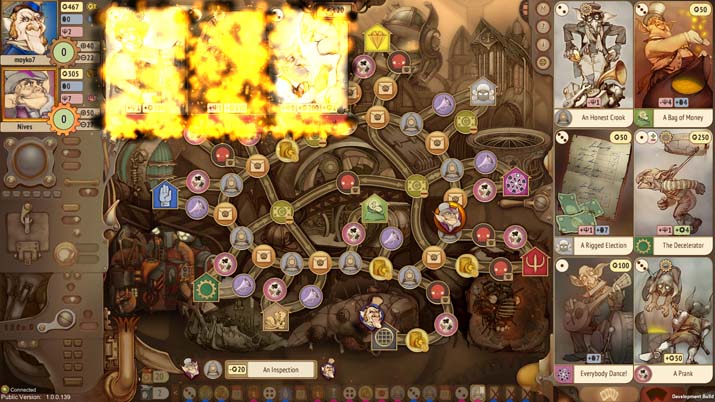Right, so in reviewing Gremlins, Inc., I found myself immediately having to consider the game on two levels. The first level is the one I (and likely you, reading this) expected: that of the title itself, which is a board-game-gone-video title with a quirky fantasy-steampunk aesthetic and a heavy focus on resource gathering. In that regard, Gremlins, Inc. is straightforward, as was my judgery of it as a digital board game, which I’ll get to momentarily (spoiler: It’s a damn fine title).

However, Gremlins came to my desk in a bit of a unique situation that caused me to have to consider it on a second, quite different level. The industry scuttlebutt about Gremlins, which is primarily meant to be played in 4-6 player multiplayer matches (though you can play with 2-3 online, or against the AI by yourself), is that it might, maybe, perhaps just be that most elusive thing in gaming: A Title That Will Work for eSports.
It would be putting it with more than a tiny bit of mildness to say that this is a claim that does not work out for most developers, especially indies. Hell, not even Batman and a batboat full of AAA Warner Bros. cash can force an eSports success story on us picky players; what chance does a digital board game with an all-new IP by a small studio have? Welp, that’s the question I had too, and why this review had me thinking about Gremlins, Inc. not just for what was there, but for the potential locked within it.
Before we get to that, let’s look at the actual gameplay of Gremlins, Inc. Gremlins is a competitive resource-gathering strategy title, but think more character-focused titles like Talisman, or even Monopoly, than big-picture entries like Catan or Splendor. You have an avatar — one of 12 gremlins, each with unique abilities, starting locations, and ways of interacting with the board (usually related to one of the resource types) — and you move it about the board in order to visit locations in the gremlin town. At each site, you can (hopefully) trade a card or two (or three, if you’re good) in for resources and/or beneficial events. The goal is to earn “Score Points," either up to a certain amount or before a certain period (time or number of rounds).
It’s a frenetic race against your fellow gremlin-preneurs to achieve this fantasy-capitalist glory.

The path to Score Points is impressively varied, with a huge number of ways to earn (and lose) them, and it became clear to me after a few rounds that the trick of Gremlins is to balance your focus on points with the acquisition of the three other resources (Gold, Votes, and Malice). Ignore a resource, and you risk being too broke, underpowered, or hated to get anything done. Making things even more complex, the cards in your hand each have both a movement value and a set of actions, but you can only ‘spend’ the cards in one of these ways: either moving with them or activating their action. This makes cards perhaps the most valuable resource, but also the most volatile, since you literally must spend a card (almost) every turn – not to mention the excellent chance that someone will do something super capitalistic and yank one or more cards from you, shattering your current strategy and thus your dreams of an easily won match.
The result of all the many, many installments of this title (far too numerous to go into in a short review) is, at first, total chaos, albeit one that’s pretty and engaging. Resources and malice letters and avatars zoom and zip across the board like maddened hornets, and, within one round, you can go from rich in cards and Gold, steps away from your next goal, to destitute, in jail, and with enough Malice points to make you the most hated player in the match (that’s a thing in Gremlins, Inc.). Luckily, you don’t have to keep track of any of these numbers yourself; the game does all the counting and it won’t let you break any rules ‘accidentally’ (a massive advantage of digital board games over paper, something I say as a huge fan of the ole cardboard and dice).
But even with this automation, it’s still a title with a huge amount of moving pieces. Although the chuckle-inducing tutorial was fairly well done, Gremlins seems like a lot to grasp when you first dive intoit, but the gorgeous art and the intentional goofiness of the “story” (who doesn’t like the idea of being a conniving, money-grubbing gremlin?) kept gameplay light and fun… even when I was taking a few rounds to figure out what the hell I should actually be attempting. But it wasn’t before long that I’d started to understand the strategies I should be employing and, in no time at all, I was full-on gremlin-ified, with the wherewithal to pull off some devious, dastardly deeds.
This is a good game, both as an entry in the digital board game world and simply as a video game, period.

There’s a present RNG factor, and it seems difficult at first, but a better word for it is deep. And it’s much deeper once you get your bearings; now that I’m on the other side of a few rounds, all of the basic resources and concepts seem simple, and I’ve recognized that the RNG will very rarely defeat a good overall strategy, but fully comprehending those strategies for how to succeed, plus the board- and deck-awareness that you realize you’ll need to be competitive in Gremlins, has a rich depth to it, and even boggles my mind a bit.
And that’s where the whole eSports thing comes into play. If I can be forgiven for massively simplifying, the one ingredient which must exist for a game to be a viable eSports option is game elements that are understandable and recognizable by everyone, even casual players, but which require expertise to fully exploit. To do this, gameplay should be anchored in a rigid set of core rules, but there should be incredible flexibility between matches, allowing for as much in the way of personal strategy and play styles as possible.
If that’s all it takes to make a good eSports title, I think Gremlins has it made in the shade. This title has surprises and adaptive strategies coming out its mechanical wazoo. As an example, I went four whole matches without seeing a single Chaos card being used (yet another facet of Gremlins), and then I realized that if I changed tactics – going for one Chaos card in particular – I could win far faster, maybe even in two turns. Someone definitely noticed me doing that, though, and suddenly I found myself being sent to jail three times in a row, with negative cards flying at my face from every corner of the board. The strategy of the match (that single match’s meta, if you will), in just one turn went from everyone doing their own thing and inching toward the goal to everyone trying to keep one player from powering through to the end (which I damn well did, despite becoming very familiar with the town jail cells). That kind of rapid course-correction happens a lot in Gremlins, and it’s as fun to be the one slamming down winning cards as it is to be the one yanking the rug out from the wannabe victor.
Yet, the road to eSports-dom is more complicated than just having good and varied multiplayer gaming, and only time will tell if Gremlins’ strength of play is enough to get them there. For one, it’s a board game, and it isn’t ever going to be as flashy or action-heavy as a MOBA or an FPS; younger kids and mainstream players probably aren’t as likely to pick it up. You might say, “Yeah, but Hearthstone,” and you’d be partially right, but Hearthstone also does a few things Gremlins doesn’t, at least yet. One of those is making each avatar in Hearthstone feel fleshed-out and elemental, really giving you a new experience from one to the next, whereas the difference between the characters in Gremlins is much subtler and doesn’t feel nearly as visceral.
Hearthstone, DOTA 2, Overwatch, and most other big eSports titles are also crazy about adding new content and play styles, and they each give significant attention to the narrative of their respective worlds, all things Gremlins would do well to attempt to emulate. As is, Gremlins does add cards here and there, as well as some play-tweaking in updates, and (one advantage over Hearthstone) all gameplay-changing content is, and will always be, free, but one wonders what retention problems Gremlins might see if it doesn’t continue to generate new content.
Who knows, though?

I don’t know that Gremlins will ever be on ESPN, but there may well be enough players out there looking for a serious – and seriously fun – board game, one that scratches that competitive eSports-style itch; Gremlins could carve out a niche for itself in the realm of video game competition. Because, in all, Gremlins is an engrossing and exciting title that will surprise you every round and, in fact, it might be one of the best digital board games yet. I know that I certainly will be playing more of it after this review — after the utter wreckage I laid down upon my economic enemies last round, I can very readily say I’m jonesing for more gremlin-y glory — and fans of both board games and competition will find little to dislike – and a lot to get obsessed over – in Gremlins.
The Verdict
Gremlins, Inc. is a title that deserves to succeed, whether that’s at becoming the next battleground for online spectating, or whether that means earning a smaller but loyal following and setting developers Charlie Oscar up to put out even more excellent products. If you want something deep, different and definitely fun to dip into for a bit, this is one I’ll recommend all the way to the bank, where I will then play a card to steal all your money and ascend to gremlin godhood atop my never-ending pile of cash.


